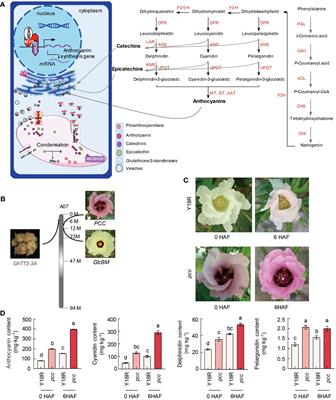Anthocyanin gene enrichment in the distal region of cotton chromosome A07: mechanisms of reproductive organ coloration
Introduction: The biosynthesis of secondary metabolites like anthocyanins is often governed by metabolic gene clusters (MGCs) in the plant ancestral genome.

However, the existence of gene clusters specifically regulating anthocyanin accumulation in certain organs is not well understood. Methods and results: In this study, we identify MGCs linked to the coloration of cotton reproductive organs, such as petals, spots, and fibers. Through genetic analysis and map-based cloning, we pinpointed key genes on chromosome A07, such as PCC/GhTT19, which is involved in anthocyanin transport, and GbBM and GhTT2-3A, which are associated with the regulation of anthocyanin and proanthocyanidin biosynthesis. Our results demonstrate the coordinated control of anthocyanin and proanthocyanidin pathways, highlighting the evolutionary significance of MGCs in plant adaptation.
The conservation of these clusters in cotton chromosome A07 across species underscores their importance in reproductive development and color variation. Our study sheds light on the complex biosynthesis and transport mechanisms for plant pigments, emphasizing the role of transcription factors and transport proteins in pigment accumulation. Discussion: This research offers insights into the genetic basis of color variation in cotton reproductive organs and the potential of MGCs to enhance our comprehension of plant secondary metabolism.
Read the full article at the original website
References:
